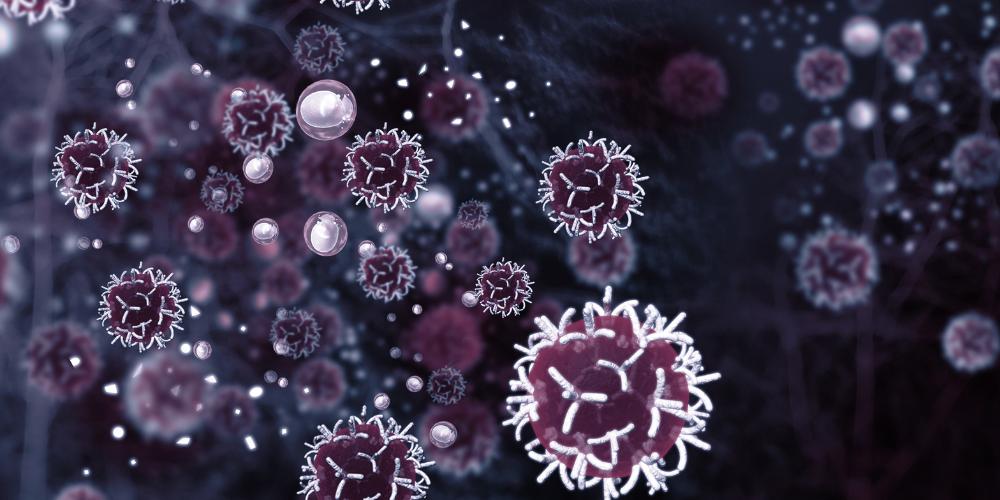What Immuno-Oncologists Need to Know About Radiopharmaceuticals
Radiopharmaceuticals are emerging as a powerful avenue for treating cancer, and Ratio Therapeutics’ CEO and CSO talk specifically how the therapy can combine with immuno-oncology to enhance activity and efficacy, for patient benefit.

What is important for an IO audience to understand about radiopharmaceuticals?
John Babich: Radiopharmaceuticals have a unique opportunity to be a companion for immuno-oncology therapies. From the data that’s coming out – larger trials looking at targeted radiotherapeutics to metastatic cancers – they don’t impact a heavy burden to the patient immunologically. That means you have the opportunity to not only reduce tumor burden and control tumor growth, but also stimulate inflammation locally on every site that the radioactivity lands on.
Jack Hoppin: We also know that the quality of life one has on those drugs, which is tied to the preservation of the immune system, is better. So while chemotherapeutics in combination with IO like checkpoint inhibitors are very additive, they stop being so effective because the chemo is so harsh. The goal, then, is a targeted therapy where the health and quality of life is maintained and hopefully you can enable an immune response.
How would radioligand therapy help to enhance an IO agent’s potency?
JB: Let's say we have a great targeting agent, like a fibroblast activation protein-α (FAP)-type targeting agent that can target the tumor in certain cases and target the tumor stroma.
We know that the tumor stroma is involved in suppressing immunological response. There are ways of peeling back that stroma, and reducing the components that might be immunosuppressive. There are some considerations, but you could actually fine-tune that response by picking the right isotope for the right application: one to hit the stroma, and one to hit the cancer cells.
"You have the opportunity to not only reduce tumor burden and control tumor growth, but also stimulate inflammation locally on every site that the radioactivity lands on."
What are you doing, to try and make radioligand therapy a reality for immuno-oncology’s benefit?
JB: We’re focused on optimizing delivery and the ratio between how much radioligand goes to the tumor versus how much is excreted. We would like to have a very high therapeutic index, and that would speak to having a healthy host, immunologically speaking, compared to high-dose chemotherapy.
That could translate to a number of opportunities in the IO space, such as giving lower dose radioactivity as an adjuvant, or mopping up the post-IO stimulation of a high-neoantigen expression environment. The idea is that we can use radioligand therapy to treat, maintaining the quality of the immune system, and having the tumor burden being irradiated to stimulate potential immunological impact.
What do we know about the actual immunological stimulation of RLT?
JH: There's a lot of radiobiology that's been done that indicates that there are cell markers of death that seem to be induced and thus can stimulate a response, but we’re going to have to see that in clinical trials.
There aren’t good studies to date that would give us good metrics of T cell and granzyme B presence at the site of the tumor. One thing to note for the IO audience: we did a partnership with Merck around a granzyme B PET ligand in patients. That could be a way to dynamically, and in the whole body, quantify and visualize the activated immune response.
"We can use radioligand therapy to treat, maintaining the quality of the immune system, and having the tumor burden being irradiated to stimulate potential immunological impact."
What would be the rationale for radioligand therapy causing an immune response?
JB: When you use either an alpha or a beta particle, the cell has no way of recovering from that injury, and it might be an interesting trigger for an IO response. If you cannot fix the damage, it has to be reported to the host somehow. That represents an opportunity.
If you were to damage the cell, but it retains the ability to survive and repair itself, there wouldn’t be an immunological response to that. We don’t have the answers, and this is incredibly complicated, but we might be able to exploit those differences in cell reaction to focus on what is more stimulatory, more antigenic, and more of a signal.
One of the beauties of radioligand therapy with the right isotope is that they can be sitting in the tumor for a week or two, stimulating almost a chronic state of inflammation, which the immune system might have a better chance of reacting to. We’re still very early in this, and there are different isotopes you can play with, as well as different types of cell death, different doses, etc. Again, this is speculation, but it’s a rich area for speculation.
Solid tumors are one of the biggest challenges facing IO. How could RLT aid in that fight?
JB: If you think of it as “peeling an onion,” that’s the solid tumor problem, in a way. The stroma is involved in most epithelial carcinomas, and there is data suggesting that the stroma is hijacked from an immunological perspective to cloak the tumor from the immune system. Our FAP ligand has shown to be very good at selectively destroying the stroma. Even beyond stimulating the immune system, if you are able to knock down one veil of the stroma at a time, you can give access to the immune system even if you don’t get rid of it completely.
JH: Data indicates that the amount of cancer-associated fibroblasts is prognostic of poor response. Similarly, if we look at the perfusion rate of something getting into the tumor, the higher the rate of transport, the better the response of that patient is going to be. Those seem to be linked.
What's unique about RLT is we don't have to hit a pathway that triggers something. When we park the drug in the tumor, it will kill whatever's there. We just need to optimize fit-for-purpose molecules that make sure that we get a lot more to the tumor for a lot longer than anywhere else.
"One of the beauties of radioligand therapy with the right isotope is that they can be sitting in the tumor for a week or two, stimulating almost a chronic state of inflammation, which the immune system might have a better chance of reacting to."
Radiation isn’t new; what has changed about the field that makes you optimistic for the future?
JB: I don’t think we have seen the full breadth of radioligands yet, to apply to the challenge of cancer. But now we have more tools, more drugs, more isotope availability, and more opportunities.
JH: One is that PET imaging, nuclear imaging, is now ubiquitous in the treatment of cancer. Being able to image a radionuclide was not something that you could do easily 15 years ago, and now you can get a whole body PET scan or a majority of the body PET scan very easily. You can see if the target is there, and if you can treat it.
Another is the amount of resources that organizations like Novartis, Lilly, Bayer, AstraZeneca and BMS have put into radiation on the heels of the very well-received Pluvicto and Lutathera. That combined with the advancement of imaging technology and the willingness of oncologists to adopt and prescribe the use of radiation. Additionally, we can find failure very quickly. It’s very easy to determine failure, even in a small patient population, which will hopefully accelerate our learnings.
In This Article










